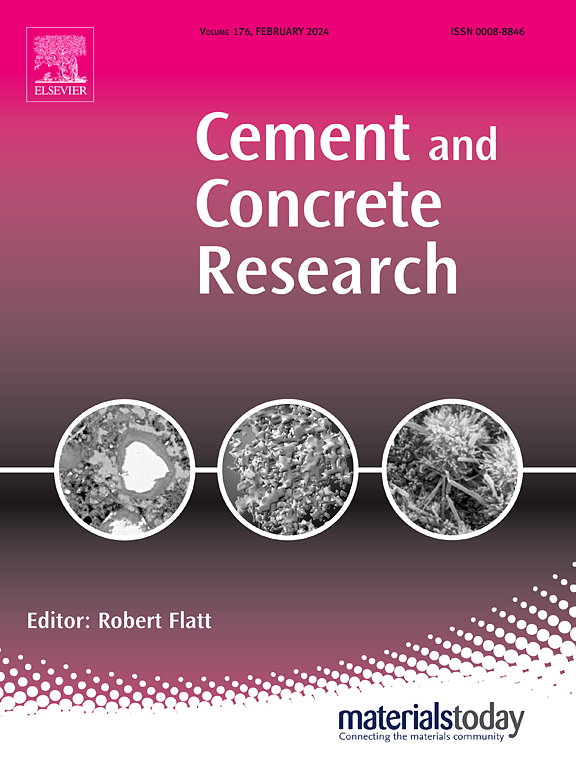Unveiling the structural build-up 3D printable cement-based materials: From small amplitude oscillatory shear (SAOS) to extensional (SAOE) rheological workflows
IF 13.1
1区 工程技术
Q1 CONSTRUCTION & BUILDING TECHNOLOGY
引用次数: 0
Abstract
Additive manufacturing with cementitious materials is rapidly advancing, yet critical challenges remain – most notably, the accurate prediction of structural stability. Current stability models often rely on numerical simulations driven by rheological properties, typically derived from shear tests linked to plasticity criteria or pseudo-elastic assumptions. However, these methods frequently lead to overestimations of critical failure heights due to an imprecise characterization of time-dependent material behavior.
This study introduces a novel approach to stability prediction by directly measuring extensional viscoelastic properties using Small Amplitude Oscillatory Extensional (SAOE) testing. These tests capture the purely reversible behavior of fresh printable materials under load, enhancing the accuracy of structural response characterization during layer deposition. From this methodology, a two-parameter structuration model was developed to predict the time-dependent evolution of the extensional storage modulus in cement-based printable materials.
To bridge the gap between shear and extensional viscoelastic properties, a comparative analysis was conducted using the Trouton's ratio, providing a potential pathway for approximating extensional properties from shear measurements. The study also proposes two stability criteria tailored to “infinite brick” and “layer-pressing" strategies, evaluated through case studies to underline their practical relevance.
By refining the methodologies for measuring and modeling viscoelastic properties, this research addresses critical limitations in stability prediction, offering novel insights for buildability assessments and advancing the field of 3D concrete printing.
揭示结构构建3D打印水泥基材料:从小振幅振荡剪切(SAOS)到拉伸(SAOE)流变工作流程
使用胶凝材料的增材制造正在迅速发展,但仍然存在关键挑战-最明显的是结构稳定性的准确预测。目前的稳定性模型通常依赖于由流变特性驱动的数值模拟,通常来自与塑性准则或伪弹性假设相关的剪切试验。然而,由于对材料随时间变化的特性描述不精确,这些方法经常导致临界失效高度的高估。本研究引入了一种新的稳定性预测方法,即利用小振幅振荡拉伸(SAOE)测试直接测量拉伸粘弹性特性。这些测试捕获了负载下新鲜可打印材料的纯可逆行为,提高了层沉积过程中结构响应表征的准确性。基于这种方法,建立了一个双参数结构模型来预测水泥基可打印材料中拉伸存储模量的随时间变化。为了弥合剪切粘弹性和拉伸粘弹性之间的差距,使用Trouton比率进行了比较分析,为从剪切测量中近似获得拉伸特性提供了一种潜在的途径。该研究还提出了针对“无限砖”和“层压”策略的两个稳定性标准,并通过案例研究进行评估,以强调其实际相关性。通过改进粘弹性性能的测量和建模方法,本研究解决了稳定性预测的关键限制,为可建造性评估提供了新的见解,并推动了3D混凝土打印领域的发展。
本文章由计算机程序翻译,如有差异,请以英文原文为准。
求助全文
约1分钟内获得全文
求助全文
来源期刊

Cement and Concrete Research
工程技术-材料科学:综合
CiteScore
20.90
自引率
12.30%
发文量
318
审稿时长
53 days
期刊介绍:
Cement and Concrete Research is dedicated to publishing top-notch research on the materials science and engineering of cement, cement composites, mortars, concrete, and related materials incorporating cement or other mineral binders. The journal prioritizes reporting significant findings in research on the properties and performance of cementitious materials. It also covers novel experimental techniques, the latest analytical and modeling methods, examination and diagnosis of actual cement and concrete structures, and the exploration of potential improvements in materials.
 求助内容:
求助内容: 应助结果提醒方式:
应助结果提醒方式:


